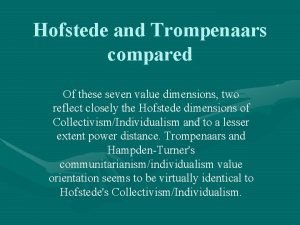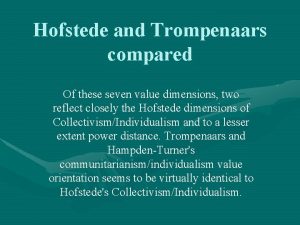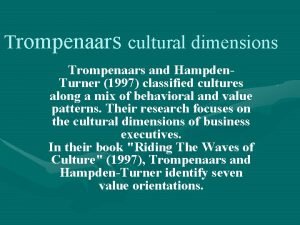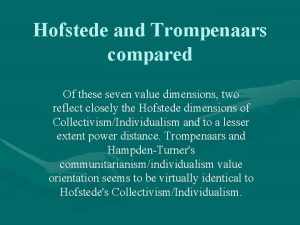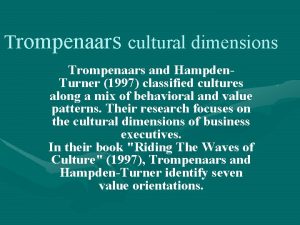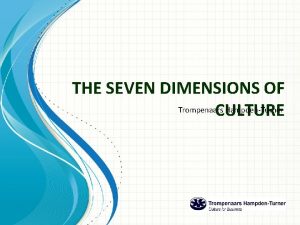Hofstede and Trompenaars compared Of these seven value












- Slides: 12

Hofstede and Trompenaars compared Of these seven value dimensions, two reflect closely the Hofstede dimensions of Collectivism/Individualism and to a lesser extent power distance. Trompenaars and Hampden-Turner's communitarianism/individualism value orientation seems to be virtually identical to Hofstede's Collectivism/Individualism.

• Their achievement/ascription value orientation, which describes how status is accorded, appears to be linked to Hofstede's power distance index, at least if one accepts that status is accorded by nature rather than achievement, and that this reflects a greater willingness to accept power distances.

• It is, however, not a complete match, as Hofstede's power index does not only relate to how status is accorded, but also to the acceptable power distance within a society, an area that is not touched upon by Trompenaars and Hampden-Turner.

• Trompenaars and Hampden-Turner's other dimensions seem to focus more on some resulting effects of underlying value dimensions. For example, their neutral/emotional dimension describes the extent to which feelings are openly expressed, i. e. a behavioral aspect rather than a value in itself.

• Their universalism/particularism value orientation, describing a preference for rules rather than trusting relationships, could be interpreted as part of Hofstede's uncertainty avoidance dimension on the one side, and to some extent the collectivist/individualist dimension.

• Their diffuse/specific value orientation, describing the range of involvement, seems to have no direct link to any of Hofstede's dimensions. Human-Time relationship is closely related, if not identical, to Hall’s polychronic and monochronic time perceptions. The Human-Nature relationship appears to be closely related to the Human-Nature relationship in Strodbeck and Kluckhohn's (1969) Value Orientations.

• An examination reveals broad consistency in the respective classifica tions of countries. For example, Japan and India are both relatively weak in terms of individualism according to both Hofstede and Trompenaars, while Denmark, the UK and the USA are relatively individualistic. However, many countries appear to be more individualistic according to Trompenaars than Hofstede's research indicates. This is particularly the case for countries such as Mexico, Greece and Spain. Differences of this kind cannot be entirely explained away by pointing to the differences in the items employed by Hofstede and Trompenaars.

• Hodgetts and Luthans (. 2000) have suggested that what is possible is that the differences may be due to the different time frames of the two studies, indicating that cultural change has taken place. In turn this implies that Hofstede's findings are becom ing out of date. For example Mexico's integration into the global economy may be generating a move away from communitarian values. In other words, 'Cultures. do not stand still; they evolve over time, albeit slowly. What was a reasonable characterization in the 1960 s and 1970 s may not be so today' (Hill, 2000: 100).

• It is also interesting to note that Trompenaars' findings indicate that former communist countries such as Russia, Hungary and the Czech Republic are relat ively individualistic despite their communist past. • Trompenaars has also extended his research by examining corporate cultures by nationality. In order to do so he introduced yet another dimension: equality versus

• hierarchy. The hierarchical corporate culture is one that is power oriented in which the leader has considerable authority and knows best. This dimension is akin to Hofstede's Power Distance dimension. Furthermore, there a number of similarities in their findings: the Scandinavian countries.

• North America and the UK have relatively egalitarian cultures according to Trompenaars, and are low in terms of Power Distance according to Hofstede. France and Spain figure as hierarchical according to Trompenaars and relatively high in terms of Power distance in Hofstede's research.

• There are, however, pronounced disagreements not least in regard to Germany. Trompenaars' findings suggest that German corporate culture is decidedly hierarchical, whereas Hofstede identifies Germany as relatively low in terms of Power Distance.
 Trompenaars seven cultural dimensions
Trompenaars seven cultural dimensions Trompenaars and hofstede
Trompenaars and hofstede Trompenaars seven dimensions of culture
Trompenaars seven dimensions of culture Contoh value creation adalah
Contoh value creation adalah Trompenaars and hampden-turner cultural dimensions
Trompenaars and hampden-turner cultural dimensions Trompenaars dimensions
Trompenaars dimensions The seven deadly sins
The seven deadly sins Hall kulturdimensionen
Hall kulturdimensionen Trompenaars kultúra modell
Trompenaars kultúra modell Trompenaars ländervergleich
Trompenaars ländervergleich Geert hofstedes
Geert hofstedes The harsh thunder of imperial power
The harsh thunder of imperial power 10 minutes with geert hofstede
10 minutes with geert hofstede
